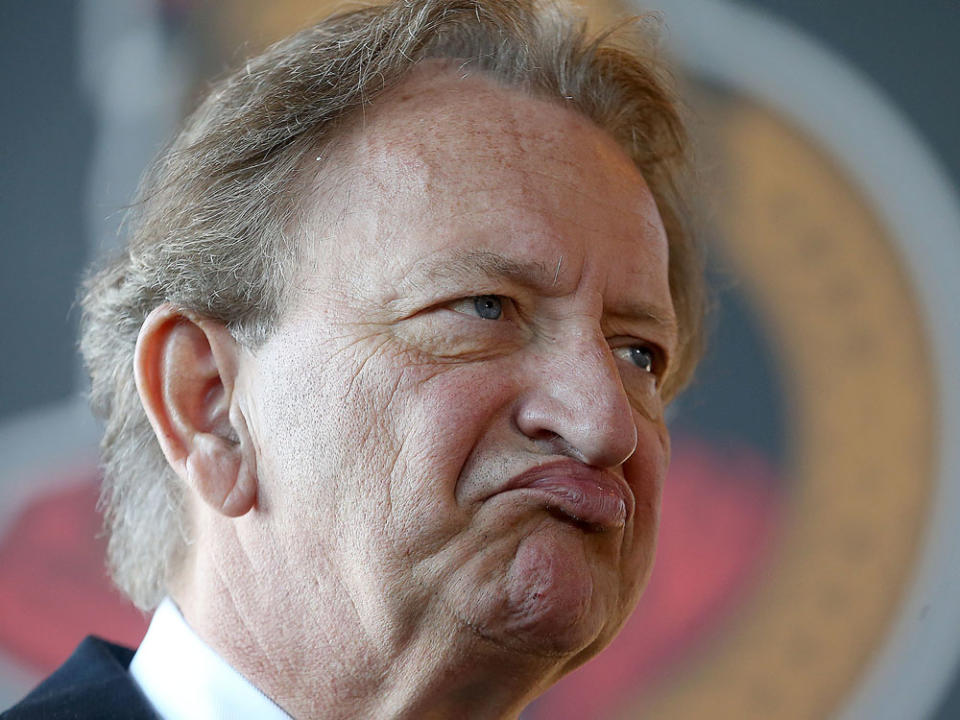Senators continue cutting costs to shockingly low levels

Check CapFriendly and you’ll see that the Ottawa Senators currently have a shade under $66 million in cap obligations, giving them plenty of room to re-sign their last remaining RFA.
Colin White is a good young player but you could probably sign him four or five times over for the $15 million or so the Sens have in remaining cap space. As ever with the Senators, the cap space is the opposite of the problem.
Eugene Melnyk’s cash-poor approach to running the organization is in evidence everywhere on this roster: It’s likely that nine players at a minimum will be earning less than a million against the cap before rookie performance bonuses. And about $8.6 million of the $66ish million in obligations are LTIR cases who won’t play a game and whose contracts will be covered (at least in part) by insurance payouts. Another $2.2 million in that total cap obligation is for buyouts on Dion Phaneuf and Alex Burrows.
Furthermore, a number of the players the Senators traded in the past few years are set to earn less in cash than their cap hits. While they’re committed to about $66 million right now in AAV money, in actual dollars it’s more like $58.7 million (again before performance bonuses rookies might or might not earn).
But also, some of that money was paid as signing bonuses, including $5.5 million or so this year alone picked up by Nikita Zaitsev, Connor Brown, and Artem Anisimov’s former employers.
So that’s more like $53.2 million in actual cash obligations, but again we’re talking about two buyouts and three LTIR candidates who won’t cost the Senators as much as all that and, certainly, won’t play a second for them in the 2019-20 season.
That means we’re talking about a ballpark estimate of about $48 million plus whatever White gets for what is maybe one or two players — low-cost vets or guys on ELCs, no doubt — away from the full 23. Even if we’re being generous and saying that gets them up to $55 million in cash payouts, they’re about $5.2 million below the NHL’s salary floor in terms of AAV.
Not that anyone is under any illusions about what’s going on here, but to see it in action remains galling from a labor perspective. All the people boohooing last week because the Maple Leafs used their institutional knowledge of the salary cap to figure out a creative way to bring Mitch Marner in (probably once the season starts), saying it was “cap circumvention,” might want to take a look under this rock. In both cases, it’s not actually circumvention, but Ontario is showing us two sides of the same coin: Violating the spirit of the CBA’s rules if not the rules themselves.
Even if we’re saying the AAVs on file here are what we should go by (and by rule, they are), the last time this Senators team would struggle to get under the salary cap is 2014-15. The cap has grown 18 percent since then. In terms of dollar expenditure, the Sens are closer to fielding a capped-out team from 2008-09; the cap’s up about 44 percent since then.
On the one hand, this maneuvering is admirable because if you’re gonna bottom out, you might as well bottom all the way out and maximize your opportunity to get as many high-end picks as you can. (One imagines a few of the vets on this team get traded for futures at some point in the season, further reducing outlay.) On the other, if you’re a Senators fan or just a fan of the NHL in general, this has to be troublesome.
Melnyk seemingly isn’t doing anything with the $25 million he’s saving by not pushing this team to the cap ceiling. That money’s not going into the front office and certainly not the scouting department, which improves the team in the long run. It’s not going to improving fans’ experience at games (not that it probably matters because who’s driving out to Kanata to watch a team with a potential top line of Boedker-Anisimov-Ryan?). It’s only going back to Melnyk, the owner who has become a vampiric presence in the league, who seems beset by scandal on a weekly basis.
You can’t get mad at a team for maximizing the extent to which they exploit the league’s needs-improvement CBA, either to take on more cap obligations like Toronto or avoid as much financial obligation as possible. But you can certainly take the latter as a sign of malfeasance and dereliction of duty.
The goal of being a sports franchise is ultimately to be competitive for something. Even if you’re a tanking team, the long-term goal is to be competitive despite the near-term intention of losing. Melnyk has pledged to spend close to the salary cap starting in 2021, and as of now he only has two players signed for 2021-22, so that’s an insane amount of cap flexibility.
But with all these moves portend a rather different and bleaker future, because even if the Senators really do intend to spend $85-$90 million routinely against the cap, which pending UFAs are going to take them up on any offers that aren’t totally out of whack with the market? The Senators would need every draft pick from the last few years to hit their ceilings to make them an even remotely attractive destination.
Put another way, you can’t build a skyscraper on a deteriorating foundation, and Melnyk has been taking a jackhammer to that concrete for years.
Ryan Lambert is a Yahoo! Sports hockey columnist. His email is here and his Twitter is here.
All stats/salary info via Natural Stat Trick, Evolving Hockey, Hockey Reference, CapFriendly and Corsica unless noted.
More NHL coverage from Yahoo Sports

 Yahoo Sports
Yahoo Sports 



